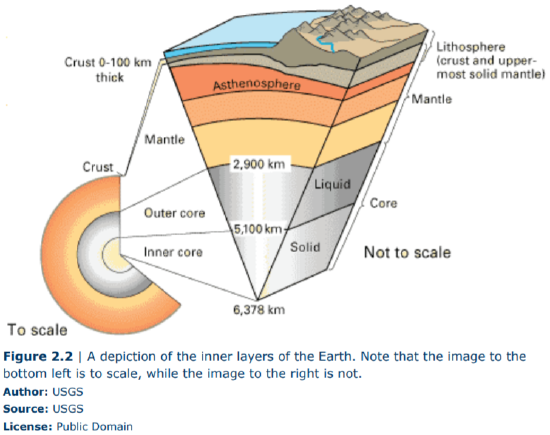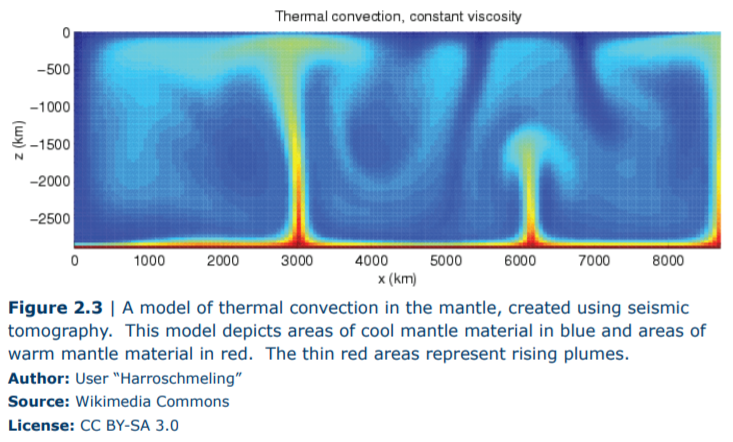2.2: Interior of the Earth
- Page ID
- 5460
\( \newcommand{\vecs}[1]{\overset { \scriptstyle \rightharpoonup} {\mathbf{#1}} } \)
\( \newcommand{\vecd}[1]{\overset{-\!-\!\rightharpoonup}{\vphantom{a}\smash {#1}}} \)
\( \newcommand{\id}{\mathrm{id}}\) \( \newcommand{\Span}{\mathrm{span}}\)
( \newcommand{\kernel}{\mathrm{null}\,}\) \( \newcommand{\range}{\mathrm{range}\,}\)
\( \newcommand{\RealPart}{\mathrm{Re}}\) \( \newcommand{\ImaginaryPart}{\mathrm{Im}}\)
\( \newcommand{\Argument}{\mathrm{Arg}}\) \( \newcommand{\norm}[1]{\| #1 \|}\)
\( \newcommand{\inner}[2]{\langle #1, #2 \rangle}\)
\( \newcommand{\Span}{\mathrm{span}}\)
\( \newcommand{\id}{\mathrm{id}}\)
\( \newcommand{\Span}{\mathrm{span}}\)
\( \newcommand{\kernel}{\mathrm{null}\,}\)
\( \newcommand{\range}{\mathrm{range}\,}\)
\( \newcommand{\RealPart}{\mathrm{Re}}\)
\( \newcommand{\ImaginaryPart}{\mathrm{Im}}\)
\( \newcommand{\Argument}{\mathrm{Arg}}\)
\( \newcommand{\norm}[1]{\| #1 \|}\)
\( \newcommand{\inner}[2]{\langle #1, #2 \rangle}\)
\( \newcommand{\Span}{\mathrm{span}}\) \( \newcommand{\AA}{\unicode[.8,0]{x212B}}\)
\( \newcommand{\vectorA}[1]{\vec{#1}} % arrow\)
\( \newcommand{\vectorAt}[1]{\vec{\text{#1}}} % arrow\)
\( \newcommand{\vectorB}[1]{\overset { \scriptstyle \rightharpoonup} {\mathbf{#1}} } \)
\( \newcommand{\vectorC}[1]{\textbf{#1}} \)
\( \newcommand{\vectorD}[1]{\overrightarrow{#1}} \)
\( \newcommand{\vectorDt}[1]{\overrightarrow{\text{#1}}} \)
\( \newcommand{\vectE}[1]{\overset{-\!-\!\rightharpoonup}{\vphantom{a}\smash{\mathbf {#1}}}} \)
\( \newcommand{\vecs}[1]{\overset { \scriptstyle \rightharpoonup} {\mathbf{#1}} } \)
\( \newcommand{\vecd}[1]{\overset{-\!-\!\rightharpoonup}{\vphantom{a}\smash {#1}}} \)
\(\newcommand{\avec}{\mathbf a}\) \(\newcommand{\bvec}{\mathbf b}\) \(\newcommand{\cvec}{\mathbf c}\) \(\newcommand{\dvec}{\mathbf d}\) \(\newcommand{\dtil}{\widetilde{\mathbf d}}\) \(\newcommand{\evec}{\mathbf e}\) \(\newcommand{\fvec}{\mathbf f}\) \(\newcommand{\nvec}{\mathbf n}\) \(\newcommand{\pvec}{\mathbf p}\) \(\newcommand{\qvec}{\mathbf q}\) \(\newcommand{\svec}{\mathbf s}\) \(\newcommand{\tvec}{\mathbf t}\) \(\newcommand{\uvec}{\mathbf u}\) \(\newcommand{\vvec}{\mathbf v}\) \(\newcommand{\wvec}{\mathbf w}\) \(\newcommand{\xvec}{\mathbf x}\) \(\newcommand{\yvec}{\mathbf y}\) \(\newcommand{\zvec}{\mathbf z}\) \(\newcommand{\rvec}{\mathbf r}\) \(\newcommand{\mvec}{\mathbf m}\) \(\newcommand{\zerovec}{\mathbf 0}\) \(\newcommand{\onevec}{\mathbf 1}\) \(\newcommand{\real}{\mathbb R}\) \(\newcommand{\twovec}[2]{\left[\begin{array}{r}#1 \\ #2 \end{array}\right]}\) \(\newcommand{\ctwovec}[2]{\left[\begin{array}{c}#1 \\ #2 \end{array}\right]}\) \(\newcommand{\threevec}[3]{\left[\begin{array}{r}#1 \\ #2 \\ #3 \end{array}\right]}\) \(\newcommand{\cthreevec}[3]{\left[\begin{array}{c}#1 \\ #2 \\ #3 \end{array}\right]}\) \(\newcommand{\fourvec}[4]{\left[\begin{array}{r}#1 \\ #2 \\ #3 \\ #4 \end{array}\right]}\) \(\newcommand{\cfourvec}[4]{\left[\begin{array}{c}#1 \\ #2 \\ #3 \\ #4 \end{array}\right]}\) \(\newcommand{\fivevec}[5]{\left[\begin{array}{r}#1 \\ #2 \\ #3 \\ #4 \\ #5 \\ \end{array}\right]}\) \(\newcommand{\cfivevec}[5]{\left[\begin{array}{c}#1 \\ #2 \\ #3 \\ #4 \\ #5 \\ \end{array}\right]}\) \(\newcommand{\mattwo}[4]{\left[\begin{array}{rr}#1 \amp #2 \\ #3 \amp #4 \\ \end{array}\right]}\) \(\newcommand{\laspan}[1]{\text{Span}\{#1\}}\) \(\newcommand{\bcal}{\cal B}\) \(\newcommand{\ccal}{\cal C}\) \(\newcommand{\scal}{\cal S}\) \(\newcommand{\wcal}{\cal W}\) \(\newcommand{\ecal}{\cal E}\) \(\newcommand{\coords}[2]{\left\{#1\right\}_{#2}}\) \(\newcommand{\gray}[1]{\color{gray}{#1}}\) \(\newcommand{\lgray}[1]{\color{lightgray}{#1}}\) \(\newcommand{\rank}{\operatorname{rank}}\) \(\newcommand{\row}{\text{Row}}\) \(\newcommand{\col}{\text{Col}}\) \(\renewcommand{\row}{\text{Row}}\) \(\newcommand{\nul}{\text{Nul}}\) \(\newcommand{\var}{\text{Var}}\) \(\newcommand{\corr}{\text{corr}}\) \(\newcommand{\len}[1]{\left|#1\right|}\) \(\newcommand{\bbar}{\overline{\bvec}}\) \(\newcommand{\bhat}{\widehat{\bvec}}\) \(\newcommand{\bperp}{\bvec^\perp}\) \(\newcommand{\xhat}{\widehat{\xvec}}\) \(\newcommand{\vhat}{\widehat{\vvec}}\) \(\newcommand{\uhat}{\widehat{\uvec}}\) \(\newcommand{\what}{\widehat{\wvec}}\) \(\newcommand{\Sighat}{\widehat{\Sigma}}\) \(\newcommand{\lt}{<}\) \(\newcommand{\gt}{>}\) \(\newcommand{\amp}{&}\) \(\definecolor{fillinmathshade}{gray}{0.9}\)Overview
 The study of seismic waves and how they travel through the Earth has been very useful in helping to determine the changes in density and composition within the Earth and in locating the boundaries between the inner core, outer core, mantle, and crust. Seismic waves are energy waves generated during earthquakes; two types known as P and S waves propagate through the Earth as wavefronts from their place of origin. P-waves are compressional waves that move back and forth like an accordion, while S-waves are shear waves that move material in a direction perpendicular to the direction of travel, much like snapping a rope. The velocity of both of these waves increases as the density of the materials they are traveling through increases. Because most liquids are less dense than their solid counterparts, and seismic velocity is dependent on density, then seismic waves will be affected by the presence of any liquid phase in the Earth’s interior. In fact, S waves are not able to travel through liquids at all, as the side to side motion of S waves can’t be maintained in fluids; because of this, we know that the outer core is liquid.
The study of seismic waves and how they travel through the Earth has been very useful in helping to determine the changes in density and composition within the Earth and in locating the boundaries between the inner core, outer core, mantle, and crust. Seismic waves are energy waves generated during earthquakes; two types known as P and S waves propagate through the Earth as wavefronts from their place of origin. P-waves are compressional waves that move back and forth like an accordion, while S-waves are shear waves that move material in a direction perpendicular to the direction of travel, much like snapping a rope. The velocity of both of these waves increases as the density of the materials they are traveling through increases. Because most liquids are less dense than their solid counterparts, and seismic velocity is dependent on density, then seismic waves will be affected by the presence of any liquid phase in the Earth’s interior. In fact, S waves are not able to travel through liquids at all, as the side to side motion of S waves can’t be maintained in fluids; because of this, we know that the outer core is liquid.
If the Earth was completely homogeneous, the P and S waves would flow in straight lines. They don’t behave this way, however. As the waves travel through materials of different densities, they are refracted, or bent, as their direction and velocity alter. Sometimes these refractions can result in shadow zones, which are areas along the Earth where no seismic waves are detected. Due to the presence of a liquid outer core, a P-wave shadow zone exists from 103°-143° (see Figure 2.1) from the earthquake origination point (focus), and a larger S-wave shadow zone exists in areas greater than 103° from the earthquake focus.
Based on the way that the Earth travels through space, we know that the average density of the Earth is 5.52 \(\frac{g}{cm^3}\). When rocks at the Earth’s surface are analyzed, we find that most crustal rocks have densities in the range of 2.5-3 \(\frac{g}{cm^3}\), which is lower than the Earth’s average. This means that there must be denser material inside the Earth to arrive at that higher average density; in fact, the core region of the Earth is estimated to have a density of 9-13 \(\frac{g}{cm^3}\). The composition of the Earth’s layers also changes with depth. The bulk Earth composition is mostly made up of iron (~32%), oxygen (~30%), silicon (~16%), and magnesium (15%). If you examine rocks at the Earth’s surface, however, you will find that oxygen is the most abundant element by far (~47%), followed by silicon (~28%) and aluminum (~8%), and lesser amounts of iron, calcium, sodium, potassium, and magnesium. Minerals made from silicon and oxygen are very important and are called silicates. So, if iron is present in lower numbers in the crustal rocks, where has that iron gone? Much of it can be found in the core of the Earth, which accounts for the major increase in density there. Review Table 2.1 below for general information about each layer of the Earth, and note how much thicker continental crust is compared to oceanic crust. Examine Figure 2.2 for a depiction of the layers of the Earth.

Note that this figure includes the terms lithosphere and asthenosphere. The lithosphere is the outer, rigid part of the Earth made up of the upper mantle, oceanic crust, and continental crust. The asthenosphere is just beneath the lithosphere and, rather than being rigid, behaves plastically and flows.
| Table 2.1 | |||
| Earth’s Layer | Density (g/\(cm^3\)) | Thickness (km) | Composition |
| Continental Crust | ~2.7-2.9 | ~20-70 | Felsic rocks |
| Oceanic Crust | ~3.0 | ~8-10 | Mafic rocks |
| Mantle | ~3.4-5.6 | ~2,885 | Ultramafic rocks |
| Outer Core | ~9.9-12.2 | ~2,200 | Iron, some sulfur, nickel, oxygen, silicon |
| Inner Core | ~12.8-13.1 | ~1,220 | Iron, some sulfur and nickel |
Relatively recent advances in imaging technology have been used to better understand the Earth’s interior. Seismic tomography has been used to give a more detailed model of the Earth’s interior. In CAT scans, x-rays are aimed at a person and rapidly rotated, generating cross-sectional images of the body. In a similar fashion, repeated scans of seismic waves are stacked to produce a three-dimensional image in seismic tomography. This technique has been used in many ways, from searching for petroleum near the Earth’s surface to imaging the planet as a whole. Figure 2.3 depicts an image of the mantle created from seismic tomography.



